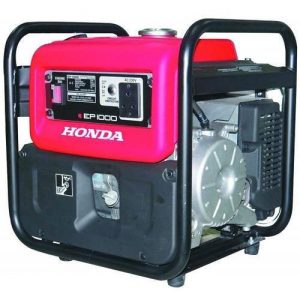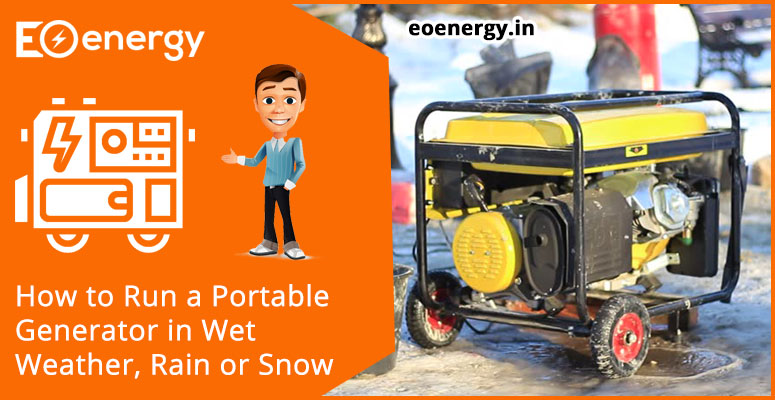Natural calamity is apt to cause a lot of problems. When using a portable generator as a support power source after a loss of power from a heavy storm or bad weather, you might run into an additional problem. We use generators in wet weather, rain, or snow & generator safety is a major concern for its user. It is not secure frequently these conditions are inescapable and they often happen when you need the generator’s power most. So Is there a solution?
Here in this blog, we provide detail information on generator safety. Also, the various tips on how to use a DG Set safely during bad weather, rain or snow.

Portable generator safety
All producers typically state very strongly and plainly that their generators should not be used in rain or other wet conditions.
- Generator manufacture powerful voltage and when you wet conditions this could guide to electrocution or some kind of discharge.
- It could also result in lasting damage to your generator.
- If any wetness were to get into the vent, it could be disastrous.
- It’s important to safety your generator from submission to moisture for protection reasons but also to keep the generator in ideal working condition.
Generator safety tips during wet condition
It’s very important to save your home or industrial DG Set from wet weather conditions or rainy sessions. Because if generator parts get the outside moisture in their parts, the parts of the generator may be damaged or the chances of short circuits will be very high.
Rain & snow can’t bo keep away from yet you sometimes have a hopeless need for power during these conditions. But you might be glad to know there are a few choices for safely using your standby generator in spite of wet conditions.
There are some safety tips you need to apply to increase the life of Genset or and also protect them from outside weather.
Use an enclosure for the generator safety
- GenTent or generator canopy safely canopies are one example of a way to safety your generator from the element while letting you safely operate it.
- This particular canopy doesn’t interfere with the portability of the generator so you can easily install it and take it down for transport to different positions.
- You might believe e that any kind of cover like this would lead the generator to overheat but the GenTent canopy continues the kind of airflow you want and encourage natural cooling.
Use a steel compound for DG Set safety
- These do provide a safe way to utilize the generator but they are quite costly and they do generally require professional installation.
- you may require to lay a pad of cement to install the compound on.
- In addition to the possibly prohibitive price, another big downside to a steal enclosure is that it is not portable.
- It’s fine to use at home but if you want to be able to take your portable generator to different places, you’ll be stuck without a secure way to power it in wet conditions everywhere else.
- You can find similar compounds made from retrofitted plastic.
- These tend to be a bit low price than the steel ones but there is a serious concern that the sheds will lead to overheating or possibly even fire.
DG Set safety rules when using a Genset
- Delicate areas of the generator, especially the outlet, should be 100% safe from moisture.
- You require to maintain some type of airflow through some type of ventilation or you will risk overheating.
- Make sure your compound can handle elements including strong wind.
- Make sure your enclosure is portable.
Apart from these generator safety tips, you need to keep way your portable power backup from damage and electrocution. Also, never use your power generator in moist weather, unless you use a generator tent. Always remember that electricity & water do not blend.
Doing this lead to a short circuit.
Never operate a generator garage and indoor
It does not affaire even if you left the doors open. Never do this. The consequences can be calamitous. It can lead to CO poisoning. Whenever you want to use the generator, go outdoors, at least 20 feet away from the nearby building. Remember that carbon monoxide is an instant killer.
Turn off the main control before starting the generator
It is very chief to do this. Once the generator starts and goes into a slothful mode, you can now turn on the main switch. Most generators that have come into the market not long ago do have a main on/off switch.
Use plastic outhouse for generator safety
Remember that, if you have a larger portable generator, then you will need in comparison costly retrofit kits. This is a specialized plastic shed. It is good to remember that the manufacturers warn against enclosing portable generators for reasons examine above.
Conclusion
Must build a good compound for your portable diesel generator, making sure that it can optionally act as a generator puzzle box. If all is good for you, make sure the special area allows you to monitor the temperature while limiting noise levels. Exciting generator experience Make good use of the suggestions above to continue enjoying the rain, sun or bad weather. Then save your generator and follow the rules.
I hope this article will help you with generator safety. By using these simple & easy tricks you can increase the shelf life of your business or home generator.

